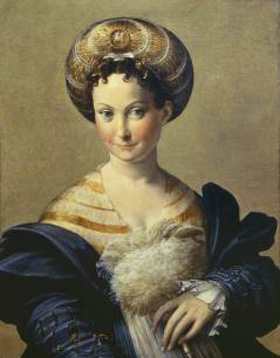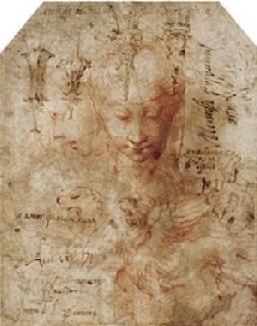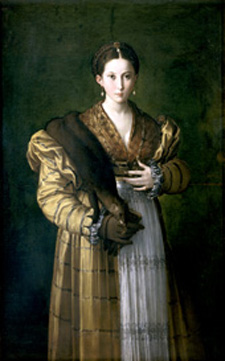The Other Woman
John Haberin New York City
Parmigianino's Schiava Turca
Who are all these women? At the Frick Collection, women have been taking center stage, and so has the enigma of their identity. The latest visitor, known for centuries as Parmigianino's Schiava Turca, again has people talking and wondering. Yet the portrait should also have them asking why they so passionately want to know.
A slave to no one
Just months ago, New York had a fresh look at the most talked about woman in art since the Mona Lisa. Girl with a Pearl Earring has become a Leonardo da Vinci for today, just as it took Modernism to secure the reputation of its maker, Jan Vermeer, an artist of unsurpassed quiet and rigor. And the museum relished the appeal of his unknown young woman's turn toward the viewer and her trembling gaze. It gave her a room to itself, apart from other Dutch paintings from the Mauritshuis—and lines formed around the block, right on cue.  Six years before, in 2008, the Frick gave that same space to another portrait and another mystery, Parmigianino's Antea. It also gave over its catalog to speculating about just who she is—standing before a green backdrop, one hand to her chest, easily holding her own in her fur stole, her satin dress, and, yes, her pearls.
Six years before, in 2008, the Frick gave that same space to another portrait and another mystery, Parmigianino's Antea. It also gave over its catalog to speculating about just who she is—standing before a green backdrop, one hand to her chest, easily holding her own in her fur stole, her satin dress, and, yes, her pearls.
Now that very artist is back with another woman, another portrait, and another cause for speculation. All one can say for sure is that she was not a schiava turca, or Turkish slave. The woman has the wealth and independence of the nobility, from the fingers coiled around her fan to her plunging neckline, billowing sleeves, and delicious curves of silk embroidered with gold. Parmigianino made quite a splash when he arrived in Rome from his native Parma, in 1524. Some hailed him as a second Raphael, perhaps especially for his portraits. Maybe not, but he was traveling in high circles when he painted this woman in the early 1530s, the same years as Antea.
Not that the Ottoman Empire was unknown to Renaissance Italy. Artists were crossing Europe to make their careers, like Bartholemeus Spranger, and Gentile Bellini had spent a year in Constantinople, beginning in 1479, before returning to carry on the first family in Venetian painting. His portraits of the sultan and a Turkish boy at his studies have the exquisite detail of a true merger of East and West. Perhaps the decorative richness of oriental drapery and reflections off gems helped stimulate the characteristic light of Northern Italian art as it turned from tempera to painting in oil. One can see its triumph in the Frick's permanent collection, with Saint Francis by Gentile's younger brother, Giovanni Bellini. What one does not see is another turban.
La Schiava Turca acquired its name in the early 1700s, when a cataloguer for the Uffizi in Florence mistook the woman for wearing one. Her fan seemed suitably exotic as well, in its ivory handle and imported feathers. Actually, her balzo, or balloon headdress, was all the rage in the Italian courts—and, as for the feathers, the Frick has other ideas, as you will see. The slave part stems from a slim gold chain slipped into her right sleeve, although it is in no danger of captivating anyone. It is one more token of wealth, refinement, and femininity, like the rouge on her cheeks and a tiny gold band on one finger. One may have to take the Frick's word for the details, for the display cordons her off at a respectful but unfortunate distance. The artist would be disappointed, but his sitter might demand no less.
The exhibition also gives her a little company, to affirm a loan from the small Galleria Nazionale di Parma as an event. A darker and slightly earlier Parmigianino portrait, from a private collection, shows a man interrupted in his study. His tall bearded face bears a not altogether approving gaze, and the swift gesture of his right arm ends with his thumb holding his place in a book. The man's mute colors and slightly confused pose mark the painting as a lesser work, but also a splendid example of Mannerism. Browns clash with browns and the lines of a high window, in sharp perspective, with the man's head and shoulders. The self-conscious experiments of that first generation of the late Renaissance were meant to leave one uneasy, and they still do.
Three other paintings, all from the Frick, complete the story of the early sixteenth century and the Renaissance portrait. Titian's Man in a Red Cap, from around 1510, has the clear light of the artist's early work. Every color and texture matters, from the soft red of his cap and the glowing white of his shirt to the fur trim surrounding his gloved hand on an iron sword—and every one speaks both to worldly power and quiet introspection. Titian's portrait of a writer, Pietro Aretino, sustains the High Renaissance to 1537, with more its more painterly surface and commanding volume. One never doubts that this poet could challenge princes. A mid-century Renaissance portrait by Bronzino of a young man, perhaps a page in the Medici court, consolidates the chilly victory of Mannerism in its polish and ever so sexualized undertones.
Grounds for speculation
Who, then, is that slave to no one? When Antea came to New York, I called it hardly the best of Parmigianino but at least the most enigmatic. I guess I was wrong on the last count, and I like this portrait even less. It has none of the shock and virtuosity of Parmigianino's Self-Portrait in a Convex Mirror. That savage play with convention defines Mannerism, as with Pontormo and the late Renaissance portrait, El Greco, Andrea del Sarto and his Sacrifice of Isaac, or late Michelangelo himself. Critics have connected their disillusionment to a "Neo-Mannerism" today.
What La Schiava Turca does have is high style and grounds for speculation. Parmigianino left twenty portraits that rarely make it into the textbooks, four of them of women. Their style is evident in this woman's sly self-possession at the center of all her excess. It is also evident in how the painting pulls things together. One can descend from the nested curves of her balzo to the gold arcs on her skin-tight dress or the collarbones at the base of her long neck. Everything seems flat for such a tricky artist, starting with the lightly shadowed background, but it gains in subtlety from passing light.
As for the speculation, it, too, takes off from the woman's stylishness. The curator, Aimee Ng, makes the most of the same evidence that threw an attribution off the scent in the first place, four hundred years ago. The hat? Look closely, and it centers on a gold medallion that depicts Pegasus, the winged horse who brought thunder and lightning from Mount Olympus. Starting in the Renaissance, Pegasus had become a symbol of poetic inspiration. Ng notes that a prominent poet of the time took it as his emblem.
 The fan? The Italian for feather resembles the word for pen, not surprisingly given quill pens. The chain? One thinks naturally of the chains of love, much the same bond as the woman's ring. Put them all together and one has a painting about poetry's craft, subject, and inspiration, in love. This woman is not just the center of attention, but the font of an art.
The fan? The Italian for feather resembles the word for pen, not surprisingly given quill pens. The chain? One thinks naturally of the chains of love, much the same bond as the woman's ring. Put them all together and one has a painting about poetry's craft, subject, and inspiration, in love. This woman is not just the center of attention, but the font of an art.
Now the speculation adds a further twist, starting with the quarter turn of the woman's pose. The Frick sees that pose, like the medallion, as typical of men alone in portraiture, making her their equal—and it sees her as far too collected to plead for love. It sees the painting as about not just the inspiration for poetry, but a poet herself. From there, it goes on to track down an actual woman poet who passed through the artist's courtly circles. Veronica Gambera was even friends with Parmigianino's teacher, Correggio. The Turkish slave has become the most independent of women.
Not bad—a groundbreaking woman for a groundbreaking painter. Does it work? Each visitor will have to judge, but I have my doubts. Gambera, Ng takes care to admit, was an older woman. True, Titian around the same time painted a noblewoman in her sixties as a young woman, but surely that was not just flattery, but also imagining the past, much as people today save old family photos. Why would Gambera, at the peak of her career, be looking back?
Who wants to know?
Why, too, would she take all that care to disguise her vocation in vague symbolism and high fashion? With Aretino, one never doubts that the unseen writing hand could at any minute come forth with gusto. With the man in a red cap, one never doubts that he is capable of looking within. With Parmigianino's other portrait, a book itself takes center stage, and the man will not lose his place in it on your account. Bronzino's young man boasts of his love, with the medallion in his right hand, because he boasts of everything. This woman hides her gold chain in her sleeve while fondling her symbolic pen with her nonwriting hand—and it sure looks like a fan.
Could she be instead an emblem of poetic inspiration after all? With Antea, the Frick speculated that it had an emblem rather than a true portrait. In the same way, Girl with a Pearl Earring might have depicted no one in particular and been on sale to anyone, so that they could tell their own stories. Again I have my doubts, because with Antea Dutch genre painting lay nearly a century away, but this time the genre might well apply. If so, La Schiava Turca caters to no man, because she is not simply an object of desire, as in many a portrait. No, she exists in the realm of true poetry and true love.
Should you care? The issues keep circling back not only to who she was, but also to why one wants to know. Maybe you do not. The story thus far may strike you as tedious, a distraction from "just looking." I have had to argue in the past for why attributions matter, why long-forgotten subjects are interesting, and why art takes words and not just looking. People might not be gossiping even now about Girl with a Pearl Earring and Vermeer's women without help from a best-selling novel and a film with Scarlett Johansson. 
Yet people did buy the novel, and they did line up at the Frick. Fine art is now closer to popular entertainment and big business, just as on a night in Chelsea under the High Line—or yet another day at the art fairs. One would never have had so many highly partial glimpses of Parmigianino, a single Mannerist, without the accidents of transcontinental museum politics. And people still treat young women differently, as objects of wonderment rather than as subjects in their own right, with or without the poetry. In the loans from the Mauritshuis, no one doubts the identity of twin portraits of a married couple by Franz Hals, and few sought out their names.
Yet one also cares about this woman's identity because of a change in the past, one that artists from Titian to Bronzino did so much to enable. Portraits gained in stature alongside religious and mythic subjects, and they became more available to all. Painters could now accord a growing middle class its art, rather than just kings, sultans, and Turkish slaves. And art, in turn, raised expectations of a human connection to its subjects. You were supposed to wonder about the motives and feelings of people in a painting, because they could be your motives and your feelings as well. They could also be the artist's, and Vincent van Gogh or Abstract Expressionism here we come.
Postmodernism tries to peel away the veneer of the natural, with good reason. Girl with a Pearl Earring, say, or Antea is not just a portrait or a story. It is first and foremost the expression of private longings and public conventions. Still, Parmigianino knew how to exploit them as much as anyone. Stick with La Schiava Turca, and you may recognize someone you know. She just will not be a Turkish slave.

"The Poetry of Parmigianino's 'Schiava Turca' " ran at The Frick Collection through July 20, 2014. Related reviews look at "A Gracious and Beautiful Manner: The Art of Parmigianino," Parmigianino's "Antea", and who lies behind art's images.




